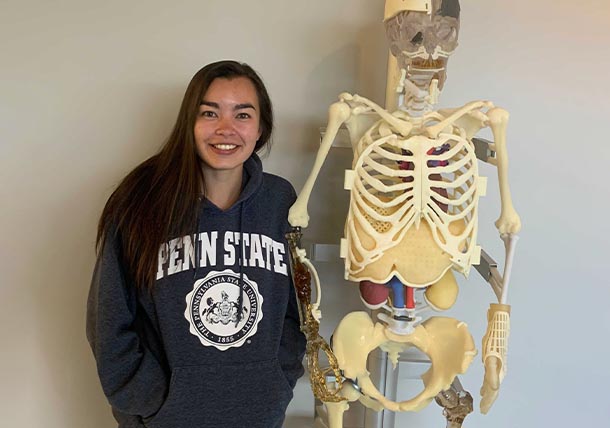
Lauren Judkins poses with a faux skeleton outfitted with a 3D-printed rib plate implant. CREDIT: IMAGE PROVIDED. ALL RIGHTS RESERVED.
3D-printing surgical implants inspires engineering graduate student
Mechanical engineering’s Lauren Judkins shares how designing custom implants could improve patient outcomes for rib injuries
1/5/2022
By Erin Cassidy Hendrick
UNIVERSITY PARK, Pa. — Advancements in additive manufacturing, commonly referred to as 3D printing, have the potential to significantly improve health care, allowing for surgical implants to be custom designed for each patient. Lauren Judkins, a graduate student in the Penn State Department of Mechanical Engineering, is adapting these advancements to enhance the recovery of patients who experienced rib injuries.
“To create designs specifically for each unique patient, 3D printing is a necessity,” Judkins said. “I’m really motivated by the impacts my work could have on human health in the future.”
Flexibility for fixation plates
Working in the Systems for Hybrid-Additive Process Engineering Lab, known as the SHAPE lab, led by Guha Manogharan, the Emmert H. Bashore Faculty Development Assistant Professor of Mechanical Engineering, Judkins investigates how to 3D-print rib fracture fixation plates.
“When people injure their ribs, sometimes a plate is surgically implanted to secure two pieces of broken ribs,” she said. “The way human bones work, the stiffness of the bone changes in relation to its length.”
The ends of the rib bone are naturally stronger, while the middle tends to be more flexible. However, the currently used surgical implant plates have a consistent strength throughout.
“3D-printing these plates could give you flexibility to mimic the structure of the bone itself,” Judkins said. “We can keep the same external geometry but change the internal structure by using lattices or different techniques to match the flexibility of the plate with the flexibility of a person’s rib.”
Supported by a Manufacturing PA Innovation grant and in collaboration with Johnson & Johnson and University of Pennsylvania, this biomechanical approach could accelerate healing, by supporting more natural movement and support to the ribs, according to Judkins.
After creating computational models of these designs, Judkins 3D-printed test plates for mechanical testing with artificial rib bones this semester. She presented this work at the 2021 American Society of Mechanical Engineers International Mechanical Engineering Congress & Exposition in November 2021.
Printing personalized implants
In collaboration with the Biedermann Lab for Orthopaedic Research at the University of Pennsylvania, Judkins and Manogharan are currently exploring how bio-absorbable zinc medical implants surgically installed at fracture sites might improve healing.
They plan to design implants that will be implanted into sheep and study how they slowly disintegrate over time by releasing naturally occurring mineral zinc at the fracture site while maintaining sufficient mechanical support. One day, the researchers hope to translate this knowledge to humans.
“This disintegration could potentially improve healing at the fracture site,” Judkins said. “Not only by providing zinc to support bone growth and regeneration, but also by slowly reintroducing movement and removing the bulk support the implant would provide.”
She explained that they plan to use 3D printing indirectly by producing customized wax patterns for investment casting to create the implants. The project is ongoing and will continue throughout Judkin’s graduate studies at Penn State.
Fabricating the future
Judkins interned at 3D Systems, known as 3DS, a company that specializes in medical device manufacturing located near Denver, Colorado, in the summer of 2021. During her time at 3DS, she designed experiments to identify characteristics and variables of biomedical devices, such as patient specific surgical guides, that were 3D-printed using the Figure 4 platform. She worked with Zach Wilczynski, a product development manager at 3DS and Penn State alumnus, whose team creates patient-specific surgical tools and implants utilizing additive manufacturing.
“I was helping to create the documentation to verify what’s being printed is done within a set of acceptable tolerances,” she said, explaining 3DS can provide that information to customers who want to use the Figure 4 platform to 3D-print their designs.
Judkins accepted a full-time job offer at the company and plans to join them in the summer of 2022 after her upcoming graduation in May. She will utilize the accumulated academic and industry experience from her internships to develop innovative medical devices and processes as a product and process development engineer.
Envisioning her career in the industry, she said she is excited to continue to add knowledge to the field.
“The impacts we could have on the medical field are significant,” she said. “The fact that there is so much left to study and characterize makes it super exciting.”



